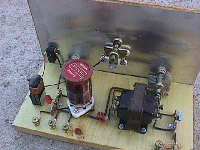
I enjoy building QRP (low power) ham radio equipment from scratch.
Since I am never willing to pay big bucks for metal chassis readily available
on the market, I build my radios in unusual containers-- in fact that
is my trademark in my hometown and local Ham Radio Club. When I am
ready to build another radio, I take a stroll through Wal-Mart to look
for pans and other metal containers that are begging to be turned into
radio equipment. Below, enjoy a view of my HOMEBREW QRP RADIO COLLECTION:
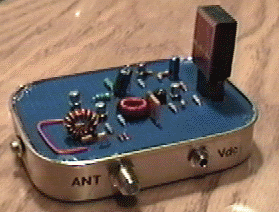
This is my latest transmitter project (Nov 16, 1997). It is a 1.5 Watt 40 Meter transmitter
built into a sardine can. I use this crystal controlled transmitter in conjunction
with my Heathkit HW-10B receiver to make CW (morse code) contacts on 40 Meters.

I build this radio in 1991 when I was in college. This is a 40 Meter transmitter build into a tuna fish container. The transmitter generates 300mW (1/3 Watt) and the evening I finished building this radio, I put it on the air and contacted another HAM in Iowa using CW (Morse code). From the U.P. of Michigan, that sure is a long haul for 1/3 Watt!
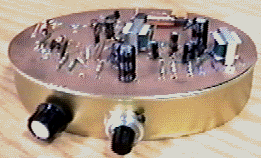
This 40 Meter (7 MHz) receiver is built into an oval sardine can. I built this receiver in 1994 to pair up with the tuna transmitter. The reciever is a direct conversion and it receive the lower portion of the 40 Meter HAM band where the CW stations hang out.
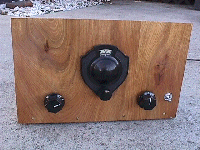
This is my latest receiver project (October, 1999). Featured here is a classical
Doerle 2-tube regerative receiver. However, instead of using the tubes, I modernized
the circuit using the common MPF-102 JFET. This receiver performs quite well for such a
simple design. It was constructed using early Hammarlund capacitor and Hammarlund 6-pin
coils. The front view shows the 1922 vernier dial used for the main tuning; the rear view
shows the Hammarlund coil and the insterstage audio transformer. I used brass hardware
for all the external connections.

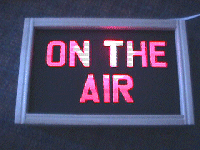
In the early 1990's I visted an amateur friend of mine in Marquette, Michigan who owned
a commercially made "On The Air" sign. The sign was mounted above the door entering his ham
shack. I offered to buy the sign from him but he refused to part with it. So, this month
(Nov. 1999) I decided to make my own. This sign is made from plexiglass, paint, and tape.
I stencilled the words on both sides of the plexiglass and masked them off. Both the front
and back surfaces are painted with several layer of black paint. Finally, the red lettering
was created using red, transparent tape. The box is built out of maple and the sign is lit
using a 7 Watt nightlight bulb.
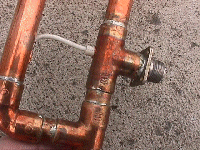
I think every amateur has built one of these 2 Meter J-Pole antennas at one time, or at
least you have seen one in operation. I have built several, myself. During the fall of
1998, Ron, W0NYQ and I got together and built up a few of these "Copper Cactus" antennas.
Ron decided to improve on the design (I cannot take credit for this variation). Instead of
mounting the SO-239 coax connector to the copper pipe using a rivet, thus exposing the backside
of the connector to the natural elements which usually results in corrosion, Ron came up
with the idea of solding the connector to a copper "T". The entire SO-239 is sealed from
the weather. The center conductor is then passed through the opposite side of the "T" through
a small hole and ceramic bead for insulation.